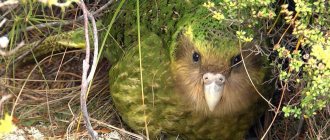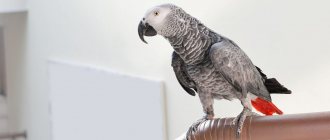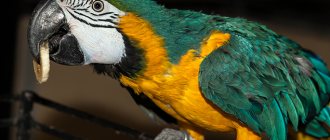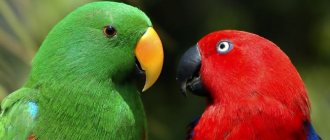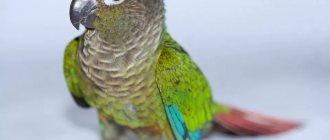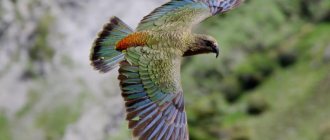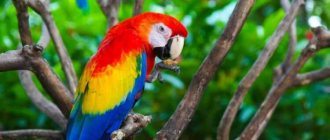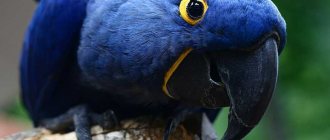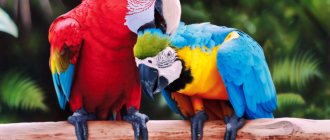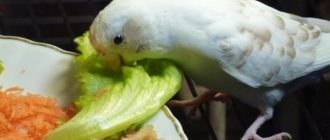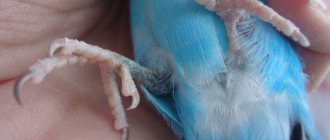Appearance
Kakapo are large birds, the length of which reaches 60 cm, and the weight is 2-4 kg. They have a special anatomy:
- The head is rounded, with a light-colored facial disc.
- The beak is massive, curved, colored gray.
- The eyes are dark, close-set.
- The body is large, with a shallow sternum, wide pelvis and low, shortened keel.
- The legs are short, massive, with 4 big toes.
- The tail is short and thick. It has a shabby appearance due to the fact that the kakapo constantly drags it along the ground.
- The wings are short, weak, with atrophied muscles.
- The plumage has camouflage colors. The top of the kakapo body is rich green interspersed with black, the bottom is light green. There may be dark brown stripes on other parts of the bird's body.
Interesting! Due to the presence of a light-colored facial disc, the kakapo received an alternative name - the owl parrot.
What not to do
It will not be possible to tame a parrot from the first days. It is simply pointless to force your love and friendship on a bird. Birds cannot tolerate high-pitched conversations, as well as tobacco smoke, so these factors should be completely eliminated during the adaptation period.
Under no circumstances should you reach out to the parrot, or even worse, grab it on the first day. The bird will experience even more stress and will take much longer to adapt.
Another important point is small children. They can't wait to meet the parrot, play and cuddle it. It is necessary to explain to the child that a pet is not a toy, but a living creature that needs peace and quiet. As soon as the bird gets used to one person, it will be much easier to make contact with the rest of the household.
If the budgerigar is not the first bird in the house, then it will need at least 3 weeks of isolation to adapt. It is impossible to introduce the bird to its brothers earlier, otherwise it will increase stress. In addition, a panicking pet is more susceptible to infections and other diseases. Other birds can provoke the development of some disease.
Habits and lifestyle
Owl parrots are nocturnal. During the day they hide in the shade of trees, rock cavities or earthen holes, and at dusk they emerge from their hiding places and begin to become active.
Kakapo cannot fly, but they are not afraid of heights and deftly climb trees. They use their short wings only when jumping down from branches. Occasionally, flightless parrots glide from trees, but no further than 50 m. Kakapos move with their heads lowered to the ground, and if threatened, they freeze in place and blend into the general background.
Flightless parrots have a friendly nature and, despite having strong paws with strong claws, are not able to defend themselves or attack. Kakapo communicate using a hoarse croaking voice, which transforms into an unpleasant squeal during the breeding season.
Interesting! The owl parrot has a strong, but not repulsive, odor of beeswax and honey.
Owner behavior
For the first couple of days, it is better not to disturb the bird, having first taken care of a sufficient amount of food and water. The owner needs to keep his distance, but at the same time is often in the same room with the parrot.
Talking to your pet is a key part of habituation . When a bird hears the quiet and calm voice of its owner, it gets used to the person noticeably faster.
The first close acquaintance is permissible only after 3-4 days. Everything here is individual and depends on the character of the particular pet. If the parrot begins to get nervous: move away on the perch or pull its head into its shoulders, then the acquaintance process should be postponed. The bird itself must show interest in communication or human hands.
Nutrition
Kakapo eats only plant food. Most of all he loves the fruits of the dacridium tree. The flightless parrot also eats:
- berries;
- fruits;
- fern;
- seeds;
- mushrooms;
- soft roots;
- nuts;
- moss.
Although the kakapo's beak easily grinds tough fibers, the owl parrot prefers to eat soft food. It first grinds fruits or herbs to a pulpy state, and then eats them.
How to behave with a parrot for the first time
At first, you need to take care of the bird's peace. There is no need to turn on loud music, turn on the vacuum cleaner and other loud household appliances, especially when she falls asleep. You should not make sudden movements in front of your pet's cage, as this may cause fright. First, open the cage only to clean it, add food or pour clean water. At first he will not speak and may open his beak without making a sound.
There is no need to try to pick up a wavy household member. He may get scared and even peck his owner. For the first week or even month, you can cover one side of the cage with a gauze cloth. The bird will have somewhere to hide and this way it will quickly get used to the situation.
Reproduction
Flightless parrots become sexually mature at the age of 5-6 years and have chicks once every 2 years. Their mating season begins in February-March and often coincides with the flowering of their favorite dacridium. Unlike other parrots, the male kakapo does not take part in raising the offspring and manages to fertilize several females during the season.
To attract representatives of the opposite sex, he digs holes about 10 cm deep in various places and begins to scream loudly in them. The throat sounds it makes carry over a distance of 5 km. For 3-4 months, the male kakapo runs every night between the dug holes and screams invitingly.
As soon as a female appears near one of them, the flightless parrot performs a mating dance. He swings his wings and runs in circles, now opening and closing his beak. His dance is accompanied by sounds similar to grunting, squeaking or a cat's purring.
If the male is lucky and the chosen one likes him, then his dance is followed by a short mating. Then he goes to conquer other potential partners, and the female alone arranges the nest. It nests in the cavities of rotten stumps, mountain crevices, among tree roots or directly on the ground.
The female lays a clutch of 1-2 eggs and incubates them for 30 days. Kakapo chicks are born with a white-grayish fluff and are under maternal care until they are 12 months old.
What to feed your budgie?
Keeping a budgie requires a varied and balanced diet. Budgerigars mainly eat grain mixtures. You should buy ready-made feed in transparent sealed plastic packaging to assess the quality of the feed. You can feed budgies separately with sesame, flax, oats, sunflower seeds, canary seeds, or mix them with ready-made food. In winter, you can feed your budgie with sprouted wheat or oats.
In addition to grain, budgies eat various vegetables and fruits: carrots, cucumbers, cabbage, zucchini, beets, apples, peaches, pears. From the berries, you can feed your budgie with raspberries or strawberries. In summer you can give plantain, clover and dandelion leaves. You should not collect wild plants along highways or near industrial facilities. Any greens and fruits should be thoroughly rinsed with water. Budgies should not be given mangoes, avocados, persimmons, papaya, all types of nuts, dill, green onions and buttercups.
Once a week, your budgie should be offered foods that contain calcium (cottage cheese, boiled eggs). You can give special chalk, which is necessary to obtain calcium and other trace elements. A budgerigar should be fed 2 times a day. Provide filtered water at room temperature. The water in the drinking bowl should always be fresh. Vitamins in drops are periodically added to it.
Population and species status
Until a certain time, nothing threatened the population of flightless parrots. But after Europeans learned about New Zealand, the number of kakapo began to rapidly decrease. The decline in the population was facilitated by the fact that, along with people, predatory animals that preyed on birds were brought there. And the Europeans themselves caught exotic owl parrots as live trophies. Land development and deforestation played a significant role in the decline in the kakapo population.
As a result, flightless parrots were on the verge of extinction and ended up on the pages of the Red Book. According to rough estimates, there are about 150 individuals left.
Flightless parrots are amazing birds with an unusual appearance and a peaceful disposition. They are nocturnal and for many reasons are not suitable for home keeping.
New Zealand kea parrots were pushed into the mountains by people or other parrots
Kea ( Nestor notabilis
).
Tomas Sobek / Flickr
Kea parrots live almost exclusively in the mountains of New Zealand's South Island, making them particularly vulnerable to man-made climate change. However, biologists doubted that this species is truly specialized for life in the mountains. Having compared the genomes of kea and their closest relatives, kaka, which inhabit forests in the lowlands, researchers did not identify any special adaptations to conditions at high altitudes in the former. As noted in an article in the journal Molecular Ecology
It is likely that kea were originally adapted to life on open plains and were widespread throughout New Zealand. However, the appearance of people or growing competition from kaka led to the fact that kea survived only in the mountains.
Kea ( Nestor notabilis
) are one of the few parrots adapted to life in cool climates. They live in the mountains of the South Island of New Zealand, mainly at altitudes from 900 to 2100 meters above sea level, including in alpine meadows above the forest line. Their high intelligence and the ability to eat a wide range of foods, including meat, help them survive here. Unfortunately, after the arrival of Europeans and the invasive mammals they introduced, kea numbers plummeted and now number only about four thousand individuals.
Experts fear that the kea's situation will only get worse in the future. The fact is that as man-made climate change occurs, New Zealand's mountains are rapidly warming, so the habitat to which these birds are adapted is shrinking. However, it remains unclear whether kea are really so narrowly specialized for life in the mountains. Fossils of these birds are often found in the lowlands and coasts of both of New Zealand's main islands, and even today they sometimes nest in the lowland forests of the South Island. Even high-altitude populations try to stay below the upper forest limit during the winter and breeding season.
A team of biologists led by Denise Martini from the University of Otago decided to look in the DNA of kea for signs of adaptation to mountain conditions, such as cold, low oxygen concentrations and intense ultraviolet radiation. To do this, the researchers compared the genome of the kea with the genome of its closest relative, the kaka parrot ( N. meridionalis
), which inhabits the forests of the North and South Islands of New Zealand (the genome of this species was sequenced for the first time).
The evolutionary lineages of kea and kaka diverged no earlier than 3.6 million years ago, that is, shortly after the formation of the Southern Alps about five million years ago. According to a popular hypothesis, the ancestors of the former went to conquer newly appeared habitats in the mountains, while the ancestors of the latter remained in the forests. In addition, the analysis included genome data from the budgerigar ( Melopsittacus undulatus
), peregrine falcon (
Falco peregrinus
), zebra finch (
Taeniopygia guttata
) and domestic chicken (
Gallus gallus
),
The study found that the last common ancestor of kea and kaka lived about 1.72 million years ago. To understand how these species evolved after the split, Martini and her colleagues compiled a list of the fifty fastest-evolving gene families for each. It turned out that in kea, genes associated with the functioning of the cardiovascular system, inflammatory reactions, metabolism and the formation of the nervous system evolved at the highest rates. Similar gene families evolved most rapidly in kaka.
In the next step, scientists identified specific genes in both species that are under the influence of strong positive selection. There were 79 of these in kea, and 93 in kaka (and these lists partially overlap). Among the genes that are under selection pressure only in kea are those responsible for the development of the cardiovascular and nervous systems, inflammatory reactions and metabolism. Genes that experience positive selection only in kaka perform similar functions.
Based on the genomes of kea and kaka, the authors were able to reconstruct the demographic history of these species in the period from one million to ten thousand years ago. It appears that kea numbers remained largely stable during this time period, while kaka populations on both main islands experienced a period of rapid growth between 250,000 and 100,000 years ago. About 60,000 years ago, the kaka population on the North Island began to grow again, but on the South Island it began to decline at the same time.
Overall, Martini and her colleagues found no evidence that kea are highly specialized for life in the mountains. Instead, they found some adaptations to high altitude conditions in both living species of the genus Nestor
. Genetic evidence suggests that both kea and lowland forest-dwelling kaka have experienced similar selection pressures throughout their history. Even the kea's developed intelligence is unlikely to be an adaptation to life in harsh mountain conditions, since genes associated with the development of the nervous system quickly evolved in kaka.
Researchers propose an alternative hypothesis that explains the kea's penchant for living in the mountains. They note that the separation of two modern species of the genus Nestor
occurred during a period when ice ages were regularly followed by interglacials. During cold periods, much of New Zealand's forests gave way to open spaces covered with shrubs and grasses. It is likely that the ancestors of the kea developed these new habitats, which led to separation from the ancestors of the kaka that remained in the forests. To survive here, they had to master a wider range of food and learn new ways to obtain it. In particular, this is how the ancestors of kea could include carrion in their diet.
While kaka numbers have fluctuated depending on forest area over the last million years, populations of the less specialized kea have remained stable. However, this modern distribution of kea, according to Martini and her colleagues, may be associated with human activity. It is likely that the Maori or later Europeans exterminated these parrots in the lowlands or introduced mammals that were dangerous to them. As a result, kea have survived almost exclusively in the mountains, where there are far fewer people and invasive predators. On the other hand, the kea's range may have declined due to the expansion of forests after the end of the last ice age and competition with the kaka living in them. At the same time, kaka cannot live in the mountains, so here kea avoided encounters with a related species and were able to survive.
The authors conclude by noting that their study suggests that kea are not as vulnerable to climate change as previously thought and can live in a wide range of climates. However, as New Zealand gets warmer, native forests will rise higher on the mountain slopes, so these birds will have to face increasing competition from kaka.
From 16 to 19 million years ago, a distant relative of the kea and kaka, the giant parrot Heracles inexpectatus,
. He weighed about seven kilograms and most likely could not fly. So far, this is the largest of all species of parrots known to science, both modern and extinct.
Sergey Kolenov
Cockatoos can move their head feathers
Photo: Terra Roro
Cockatoos are Old World parrots that are usually not as brightly colored as other parrot species. Their feathers lack the chemicals responsible for blue and green colors, so they have duller colors. Their most distinctive feature is the feathers on their heads, which they can move in the same way dogs can move their ears. The feathers on a cockatoo's head often rise when flying or landing, when scared, angry or excited. In other cases, they fit tightly to the bird’s head, giving the impression that they are not there at all.
